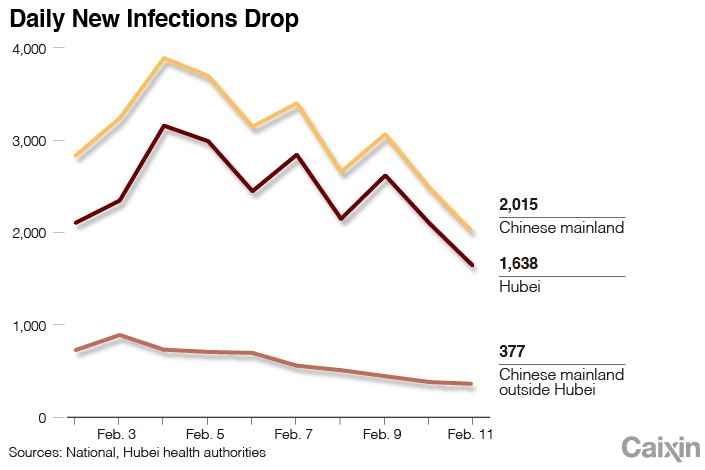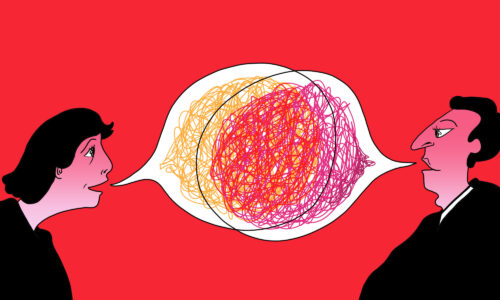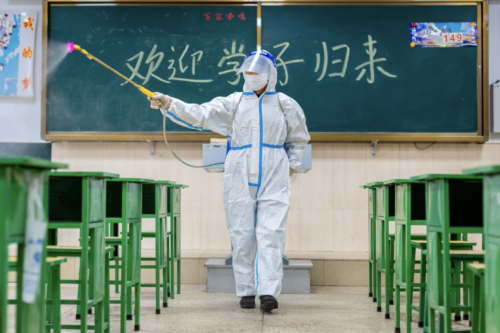Xi claims there are ‘positive changes’ in the COVID-19 epidemic


Photo credit: Caixin.
The death toll in China from the novel coronavirus-caused disease, named COVID-19 yesterday by the World Health Organization, continues to increase. The current global count stands at 1,118 deaths, 45,212 infections, and 5,133 cases where the disease has been declared cured in patients. All but one of the deaths, and nearly 99% of the reported infections, have occurred in China.
However, the rate of new infections and deaths has slowed down, according to official numbers. Per the Guardian:
Hubei…reported 1,638 new coronavirus cases on Tuesday, down from a peak of more than 3,000 new cases on 4 February and the lowest daily number of new infections since 31 January. National infection rates were also down…The number of new deaths reported as of midnight on Tuesday in China was 97. That compares with 108 reported for Monday — a fall of 10.2%. Of the new deaths, 94 were in Hubei Province.
Chinese leader Xí Jìnpíng 习近平 said today that the “epidemic situation has shown positive changes” (疫情形势出现积极变化 yìqíng xíngshì chūxiàn jījí biànhuà) at a leadership meeting on epidemic control that was featured prominently in state media (in English, in Chinese).
Note: Experts have not yet reached a consensus on when a decisive turning point in the crisis can be identified, and there remain unanswered questions about the transmission patterns of the virus. See: WHO says new coronavirus cases in China have stabilized, but warns that could change, in CNBC; When will coronavirus turning point arrive?, in Caixin; and Coronavirus still stumps experts on when human carrier turns infectious, in the SCMP.
The situation in Hubei Province remains severe, judging by the “radical requisitioning measures” that the government is authorizing there, the Financial Times reports:
Chinese authorities have begun emergency requisitioning of private hospitals, hotels, apartments, cars and even face masks as the country’s rising number of coronavirus patients threatens to overwhelm local government facilities.
But the measures, particularly the requisitioning of hospitals, have left some people with other life-threatening diseases without critical care, creating what one relative of a cancer patient affected by the seizures described as a “humanitarian” disaster.
In addition to Wuhan, major cities in other provinces are also employing these measures, including Guangzhou, Zhengzhou, Fuzhou, and Xi’an, according to the FT. Shenzhen has also been given the authority to seize private property to fight COVID-19, the SCMP says.
One district of Shiyan City in Hubei is being completely shut down, according to the Beijing News (in Chinese): “Beginning at midnight on February 12, Zhangwan District will implement wartime measures for a 14-day period,” the notice reads. All buildings are to be closed, and all people, with the exception of medical personnel, will be required to stay inside.
“Thousands of people are not getting the treatment they need because medical resources have been diverted to fight [the] outbreak” in Wuhan, the SCMP reports. Meanwhile, Wuhan residents are waiting anxiously to receive guidance on when to return to work, the Global Times reports: “Hubei Governor Wáng Xiǎodōng 王晓东 said at a press briefing on January 29 that businesses in the province could not resume operations before the end of Thursday. Many have interpreted the comment as meaning that resumption of economic activity could take place starting on Friday. Some companies even plan to resume production on Friday [February 14].”
More COVID-19 updates:
“A second Chinese citizen journalist” in Wuhan has gone missing, Quartz reports. In addition to Chén Qiūshí 陈秋实, whose family has been unable to contact him for six days, Fāng Bīn 方斌 was arrested on February 9, according to RTHK (in Chinese).
“Over two dozen large trade fairs and industry conferences in China and overseas have been postponed” because of the crisis, Reuters reports.
The United States Postal Service “will be temporarily suspending the guarantee on priority mail express international destined for China and Hong Kong, effective Monday, February 10,” a notice on its website reads, the SCMP reports.
Flaws were found in some American CDC test kits, among the 200 kits sent to labs around the U.S. and 200 more sent to labs around the world, per the New York Times.
—Lucas Niewenhuis






